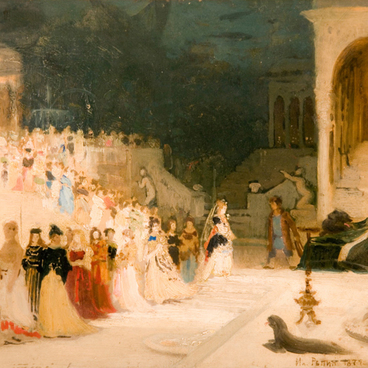Ilya Repin (August 5, 1844, Chuguev - September 29, 1930, Kuokkala, Finland) left an extensive gallery of portraits, many of which are real masterpieces in the world portrait art of the 19th century. According to the artist, he especially often painted people ‘dear to the nation, its best sons’, those who were the pride of the Russian people. Many great Russian artists, writers, musicians, and artists posed for Repin. The choice of models was largely determined by Russian philanthropist and patron of art Pavel Tretyakov. He began to create the collection of figures of Russian culture and assumed that it should become part of the gallery he had planned.
Repin confessed that of all the arts, music was his favorite. The son of a military settler from the small town of Chuguev, he got acquainted with the previously unfamiliar to him musical world already during his studies at the Academy of Arts. In his free time, he visited the choirs of the Assembly of the Nobility and listened to concerts of symphonic music. Glinka, Borodin, Rimsky-Korsakov, Lyadov, Glazunov, Liszt - all these wonderful composers were depicted by Ilya Repin in his portraits.
Repin also painted several portraits of the composer Anton Rubinstein (November 28, 1829, Vykhvatinets - November 20, 1894, Peterhof) upon Tretyakov’s request. It is known that in October 1881 Tretyakov sent a letter to the artist from Milan with a proposal to paint the outstanding musician who was then in Moscow. Rubinstein was known all over the world, he personified a rare example of “triple” artistic activity and combined the talents of a composer, pianist and conductor.
Rubinstein was the author of symphonies, oratorios and operas, and later became the initiator of the “Historical Concerts” cycle and was at the origins of professional musical education in Russia. He was the head of the Russian Musical Society, which had been created by him. Rubinstein conducted the first symphony concerts of the Society, was engaged in educational and charitable activities, taught and gave lectures. Through his efforts in 1862 the first Russian conservatory was founded in St. Petersburg. Among his students was Pyotr Tchaikovsky. Rubinstein left a large number of compositions, including fourteen secular and four spiritual operas, six symphonies, several overtures and symphonic poems, five piano concertos, chamber instrumental music, songs and ballads.
This is how Alexander Kuprin described Rubinstein in story “ The Taper’: ‘He behaved with such an elegant, imperceptibly careless and at the same time stately simplicity, which is characteristic only of people of the big world. It was evident that this man felt equally free in a small living room, in front of a crowd of thousands, and in the halls of royal palaces. The most remarkable thing was his face, one of those faces that are imprinted in memory for life at first sight… "
This description is echoed by the deeply psychological portrait of the great composer.
Repin confessed that of all the arts, music was his favorite. The son of a military settler from the small town of Chuguev, he got acquainted with the previously unfamiliar to him musical world already during his studies at the Academy of Arts. In his free time, he visited the choirs of the Assembly of the Nobility and listened to concerts of symphonic music. Glinka, Borodin, Rimsky-Korsakov, Lyadov, Glazunov, Liszt - all these wonderful composers were depicted by Ilya Repin in his portraits.
Repin also painted several portraits of the composer Anton Rubinstein (November 28, 1829, Vykhvatinets - November 20, 1894, Peterhof) upon Tretyakov’s request. It is known that in October 1881 Tretyakov sent a letter to the artist from Milan with a proposal to paint the outstanding musician who was then in Moscow. Rubinstein was known all over the world, he personified a rare example of “triple” artistic activity and combined the talents of a composer, pianist and conductor.
Rubinstein was the author of symphonies, oratorios and operas, and later became the initiator of the “Historical Concerts” cycle and was at the origins of professional musical education in Russia. He was the head of the Russian Musical Society, which had been created by him. Rubinstein conducted the first symphony concerts of the Society, was engaged in educational and charitable activities, taught and gave lectures. Through his efforts in 1862 the first Russian conservatory was founded in St. Petersburg. Among his students was Pyotr Tchaikovsky. Rubinstein left a large number of compositions, including fourteen secular and four spiritual operas, six symphonies, several overtures and symphonic poems, five piano concertos, chamber instrumental music, songs and ballads.
This is how Alexander Kuprin described Rubinstein in story “ The Taper’: ‘He behaved with such an elegant, imperceptibly careless and at the same time stately simplicity, which is characteristic only of people of the big world. It was evident that this man felt equally free in a small living room, in front of a crowd of thousands, and in the halls of royal palaces. The most remarkable thing was his face, one of those faces that are imprinted in memory for life at first sight… "
This description is echoed by the deeply psychological portrait of the great composer.



